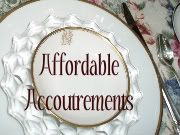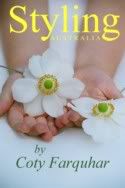For me, it's a concept that allows us to use our "Sunday best" china and silver in an unpretentious way, one that both makes our guests feel special and puts them at absolute ease. Setting a beautiful table lets friends know we value them highly and consider their presence a cause for celebration! The trick is to make it seem effortless, without appearing ostentatious or overly staged.
I generally strive for a balance between ease and elegance; I hope I've accomplished that with today's table. Let's start at the end (not my usual approach). Here's the finished table setting by candlelight:

"How exactly is this table informal?," one might ask. "Not an unreasonable question," I could respond. However:
1. It's not set in the formal dining room. In fact, it's in the sunroom, a space intended for casual relaxation.
2. The table and chairs have a definite mid-century modern feel.
3. Placemats are in use, rather than a carefully-starched and pressed tablecloth.
4. To save time and effort during the dessert course, cups and saucers are already on the table for after-dinner coffee.
5. The centerpiece consists of assorted, mis-matched silver serving pieces (from thrift shops and estate/tag sales) holding a mixture of supermarket and garden flowers, casually arranged in a "crazy quilt" of disparate colors and varying shapes.
Next, I thought you might like to see how the centerpiece began. The vase on the left contains assorted supermarket roses and two bunches of miniature carnations. They'd been reduced to less than $8 for all you see here. I cut the stems at an angle (under water) and quickly immersed them in the vase filled with lukewarm water and "flower fresh." They've been left to condition overnight.
The aluminum ice bucket on the right holds garden flowers, including some blue lacecap hydrangeas a neighbor was kind enough to provide (she knows I have a blog and offered her hydrangeas and magnolia blossoms). The shasta daisies and "red hot poker" blooms are from the cutting garden. The azalea cuttings are also from the garden.

Unless your goal is shabby chicness, there's really no way to avoid polishing the silver. I work rapidly and avoid removing the darkened areas that enhance details of the vintage silver patterns. It's part of the patina that gives pieces that desirable look of "old family silver."
Using these assorted creamers and sugar bowls as small vases gives me a chance to use, re-purpose, and display favorite pieces I've collected over time. Many of them cost as little as 99 cents at places like Goodwill. Some are sterling (those unfortunately did NOT cost 99 cents).

Since the azaleas stopped blooming weeks ago, they're here primarily to provide structure to help hold other stems in place. Hydrangeas also work well for this purpose. This approach makes it possible to avoid having to use oasis (wet floral foam) to hold flowers where you want them. Some florists say cut flowers last longer in water minus the foam. It's certainly easier to tell when additional water (or changing the water completely) is needed.
I'm using a silverplated ice bucket to hold the center arrangement and plated water pitchers for the two smaller ones.
I realize the arrangements appear tall (particularly when photographed from certain angles). I sat down, looked across to check their height, and determined that eyes could still meet across the table. In the real world, it's better to keep the centerpiece low. An easy remedy would be to use shallow containers (which probably WOULD require floral foam to hold the stems upright).
Some people like to have the table set for maximum impact as guests arrive and then move flowers to a sideboard (or into the living area) when it's time to sit down to dinner. The miniature arrangements and candles would still provide beauty and ambience, and the center of the table would be available for serving the meal "family style."

Perhaps I've done enough talking for today. Wouldn't you rather just look at the photographs? I'll list the "ingredients" at the end. The rosebud napkin fold is demonstrated in a video on the Southern Lady Magazine website. You can view it HERE.
















Perhaps you're wondering why I have such tiny glasses on the table. I have a Croatian friend who always serves strong, sweet liqueurs with dessert and after-dinner coffee. Guests can sip directly from the glasses or pour the contents into their cups. My friend also offers her guests whipped cream with their coffee. It's one of those little extra touches that can elevate a meal into an event.



















China: Theodore Haviland, "Shelton" (1952-85)
Silver: Gorham, "La Scala" (1964-)
Salt & pepper shakers: Mikasa
Wine/water glasses: Libbey/Rock Sharpe, "3006-9" (circa 1945)*
Liqueur/cordial glasses: Unknown*
Glass luncheon plates: Libbey/Rock Sharpe, "3006-9" (circa 1945)*
Tall candleholders: Godinger, Goodwill
Ornate single candleholders: Unknown, estate sale find
Tealight holders: Estate sale and Goodwill
Placemats and pink napkins: Estate sales
Green restaurant napkins: Thrifted
As noted above, the silver serving pieces are all estate/thrift finds.
*The vintage water glasses, glass luncheon plates, and cordial glasses were a definite "steal of a deal" at a local estate sale. I had admired them the first day, but decided to wait. They were still there when I stopped by during the last hour of the final day. They'd been reduced by half. I asked if they could do a little better and ended up paying 70% off the asking price! Did I need them? No. Do I like them? YES! And don't we all love a bargain?
Please join our high priestess of tablescaping, Susan of Between Naps on the Porch for Tablescape Thursdays. You'll be very glad you did!









































